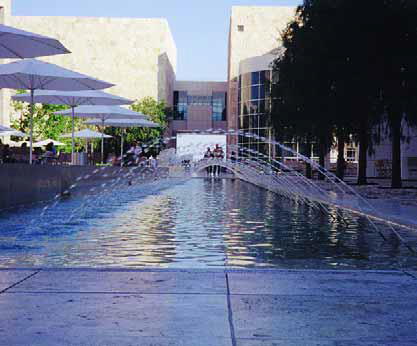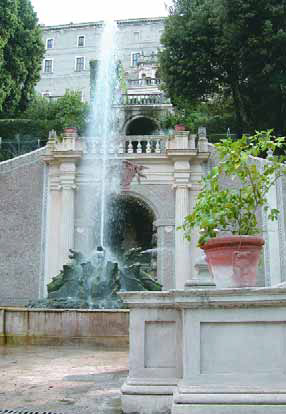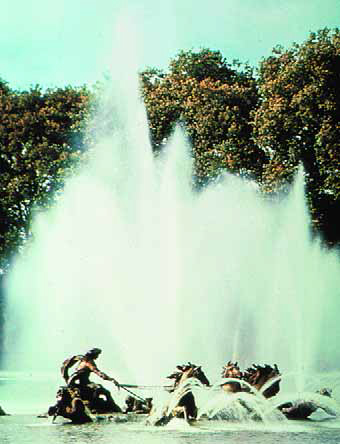The Illuminating Past

What’s the use of knowing about history?
For many of us, the answer to that question seems so obvious that it comes as a shock to find out just how many people in the watershaping and landscape fields don’t grasp the all-encompassing significance of our collective past – but it shouldn’t.
Using my own career as an example – and even though I now spend a considerable amount of my time teaching professionals and university students all about art and architectural history – I confess that I waltzed through more than a few early years as an aspiring landscape architect and watershaper in blissful ignorance of the history of much of anything, let alone art or architecture.
But when the big day arrived and I finally opened my mind to the importance of knowing the origins of what I do, everything changed: All of a sudden, my design process became far richer and much more fluid.
Indeed, becoming literate about history redefined me: Overnight, everything I was doing in the here and now was somehow being defined by connections I was making to various cultures and design traditions. Now, as I work to develop course materials about watershaping for university-level students in landscape architecture, I find myself freely professing a simple thought: “All of our new ideas stem from something that we have seen before.”
In one way or another, this is true of all the arts – and watershaping is no exception.
MASTER CLASS
In explaining all this to students, I often cite the example of Frank Lloyd Wright. It’s no knock on a towering architectural genius – a designer who utterly revolutionized his profession by synthesizing and reinterpreting Asian, Craftsman and Modernist styles – to say that he did not “invent” low, wide rooflines, for example, or that he wasn’t the first to use interesting natural materials.
Still, he’s widely credited as an innovator in these and other areas by people who have never been exposed to the work of those who inspired him. This begs the question: Do we “invent,” or are we creatures who observe and imprint our egos on what we perceive? For creative designers armed with an education in art and architectural history, the answer is both!
As a university instructor, I see incarnations of what I call “the design ego” in students when they first start to discover that they can influence the environments in which we all live. That’s a heady recognition and often leads them to believe they’re creating something new when the reality is that they’re simply pulling from their subconscious awareness of precedent and regurgitating something they perceive as new and inventive.
These kids are learning machines, but it’s easy for them to delude themselves as they put all their energy into expressing themselves in competitive intellectual environments.
Using a younger version of myself as an example once again, when I started paying attention to the history of watershaping, I quickly discovered that there are almost infinite sources for great and wonderful ideas. When we acknowledge this heritage, then we really start being “creative” as we work. Now we come to enjoy the advantages that flow from an intellectual foundation and learn ways to apply influences in new and interesting ways.
That might not be invention per se, but it’s a world of fun.
THEN AND NOW
As I’ve learned about the nature of “education” when it comes to landscape architecture students, I can’t help seeing the inadequacies of having people totally uninvolved with watershapes govern the entire curriculum. I also can’t help seeing the irony in filling young minds with information they will never use while denying them guidance not only in working with decorative and recreational water, but also failing to provide them with information on the traditions that influence both watershaping and landscape architecture.
As I’ve gotten more deeply involved in all of this, I’ve come to believe ever more firmly that it takes seeing and understanding past accomplishments to move forward and engage the future. It’s reached a point where I’ve had enough of observing and regretting this situation and have become a man of action: As I see it, my goal now is to do all I can to spread awareness of our past wherever I can – because that, too, drives action.
| Villa d’Este, Tivoli, Italy. (Above, Getty Center, Los Angeles) |
In this sense, it’s not a pure intellectual exercise; rather, this spreading of awareness is a matter of pure practicality. Although any comprehensive survey of art and architectural history is beyond the scope of this education-oriented column, I will do all I can to help everyone who reads this magazine recognize the importance of history in any sort of effective design education, whether I’m dealing with college students or those who call themselves watershapers.
In the curriculum I’m developing for my college students, I start by considering the ancient Greeks and Romans and the way they altered the entirety of the way we look at designed and built objects. Their graceful columns and arches, their pioneering work with concrete and other now-common materials of construction have all contributed to the advancement of what we consider our basic the tools of the trade.
It is a legacy that has, for generations, providing inspiration and sparked adaptations and variations that have influenced almost everything we design. To overlook the role of these designers, or worse, be completely oblivious to their influence is not only short-sighted, but is also foolish and needlessly limiting.
Working through this sort of discussion with my students has led me to believe that my fellow educators are truly being remiss when they overlook watershaping as a concept when they present the grand context of historical design traditions. And this blindness becomes absurd when you consider that the origins, the ancient roots of watershaping can be traced directly to irrigation and provision of potable water – keys to development of civilization as we know it.
FORWARD FAST
Irrigation endures as a dominant cultural need in almost all societies – a mass practical necessity – but the days when potable, everyday water was provided to urban citizens solely in centralized public fountains and wellheads are mostly long gone in industrialized nations.
Since that need for point distribution of safe drinking water has declined, fountains and pools have become almost purely ornamental (and sometimes recreational) – a transition that, in a sense, brought on the modern age of watershaping. At that point, art became the most important element in watershape design, and “impractical” criteria such as aesthetics and sound took over in guiding how, when and where we built our aquatic displays.
This new visual/auditory medium pulled architects and other designers into the picture: They shaped water as pure displays at a time when utility fell to a secondary role. But still, every time landscape architects, pool builders or fountain designers place three-tiered fountains in courtyards, they are working – whether they know it or not – within a historical trajectory that ties them directly to solutions offered by Greek and Roman designers more than 2,000 years ago.
Tracing that developmental line through millennia until we reach the present day, we can see the genius at work in modern watershapes that still reveals the influence of these longstanding traditions.
Consider the legendary Modernist architect Ricardo Legorreta, who was inspired by ancient Moorish design as well as even more ancient Roman aqueducts in creating many of his most visionary works. Or consider the dancing fountains at the Bellagio Hotel in Las Vegas, which owe their inspiration to Renaissance and Baroque palaces and the waterfeatures found, for example, at the Peterhoff and Versailles.
These are marvelous, revelatory present-day watershapes with respect to technological daring and achievement, but they also clearly owe debts of gratitude to design precedent. In this context, nothing is truly new: There is always a source for a creative vision, even if the designer is working away from it toward some new objective.
When I think about why these sorts of discussions fail to ignite interest in everyone who works with water, I concede that they can quickly devolve into intellectual exercises that induce yawns from even the stoutest among us. Just the same, when you consider the most basic functions of watershape and landscape design, it becomes brutally clear that a working knowledge of the historical foundation is utterly essential.
PRACTICALITIES
Consider, for example, the plain fact that most landscape designs begin their existence as geometric constructs known as flat plans. Whether generated using the orthographic functions of CAD or developed using circle templates and drafting triangles, these are starting places for most of what we do.
Of course, these plans lose most of their significance as a project moves forward (unless you have regular access to a helicopter). We don’t view the world with a bird’s eye; rather, we see things at an earthbound eye level, which means flat plans must be translated at some point to perspective drawings. We may take these drawings for granted, but they’re an indispensible part of the design and visualization process – and are also a legacy that has been passed down to us in the course of history.
But think about it: If you have no knowledge on how water effects look when completed (that is, if you can’t see them in perspective), then by extension it is difficult to lift them off a flat plan and design them effectively (and nearly impossible to persuade a client to trust your vision). As I see it, there’s another vital dimension to be considered: These drawn designs might stand on their own, but they will also be enriched if they are generated (and appreciated) within their historical context.
Consider the example of watershaping pioneer Thomas Church, who created what may be the first “kidney shaped” pool at a project in the Donnell Ranch area of northern California more than a half-century ago. His “invention” was based on the human experience of moving near the edge of natural lakes and ponds – a visionary leap that resulted from his keen understanding of design tradition melded with a sense of the human experience.
| The Fountain of Apollo, Versailles, France |
In pursuing this idea, of course, he inspired tens of thousands of other watershapers to do the same, so much so that the look became a cliché. Certainly, those watershapers who followed in Church’s footsteps meant to mimic a good idea and bend it to their own purposes, but I can’t help thinking if these designers had known more about Church’s thought processes, motives and sources of inspiration, organically shaped bodies of water would not have become so shopworn and dull in the years that followed.
In other words, if we widen the range of where we look and what we look at for inspiration, then we almost certainly will expand our capacity to come up with progressive, original watershapes – or at the very least will be enabled to apply the styles pioneered by Church and others in ways that are far more informed, useful and appropriate.
No matter how powerful my argument seems to me, someone always asks, “Why should I care what pools looked like in 2600 B.C.?” My answer for these skeptics is plain: You are more than welcome to keep on crafting the same pools you did in 1985, but designers who truly want to distinguish themselves and carry the torches sparked by Lawrence Halprin or Pirro Ligorio need to open their eyes and minds to the history of watershaping.
All of this is why I feel compelled (and want other instructors to feel likewise) to teach students the why and how of historical watershapes. Right now, these young minds operate in something of an information vacuum when it comes to this sort of coverage, but my experience has been that just slight exposure lets them know where to start their own investigations of relevant design history.
ARCHITECTS OF VISION
In closing, let’s consider Villa d’Este, the grand Renaissance estate in Tivoli, Italy.
This property features countless forms of weirs, spouts, streams, water chains and even the auditory thrill of a water organ. There is absolutely no way a landscape architect or watershaper could avoid being inspired after seeing such multifarious manipulations of water. You can travel there in person or simply study the place in books: The immediate result is that you see how this one place has served as the foundation for the work of hundreds of modern designers.
Mining all these riches takes work, of course. As I write these words, in fact, I’m giving a test on art and architectural history to a class of watershaping students who’ve listened to my lectures as part of a 20-hour Genesis 3 program. The test consists of 130 questions that measure their retention of information covered with hundreds of slides presented to them along with my explanations of why each is important to their professional development.
It is my honest belief that every one of my students has benefited from these presentations through the years. To be sure, some might not realize it as they toil away through this particular four-day course, but my bet is that it will mean something to them before too long.
Similarly, in the college classes I teach, my aim is to transform landscape architecture students into what I call “water architects” by giving them some understanding of how and why watershaping started. I do so despite the fact that most colleges and universities with landscape architecture programs consider informing students about watershapes a waste of time; I can only imagine what their attitude about watershaping history would be.
As I see it – and based on the response the courses I’ve taught so far have generated among students, there’s a new generation of landscape architects who want and even crave more education on water. They’ve all heard about the aqueducts of Rome and seen the pools at the Taj Mahal and know they’ve barely scratched the surface. I’m also running into faculty members who seem open to the idea of enlightening these newcomers on the architectural aspects of watershaping – encouraging if not overly enthusiastic.
Bottom line: My goal in the classroom is to expose landscape architecture students to as much watershaping history as possible to help expand and refine their design capabilities. Through WaterShapes, my aim is to share what I myself am learning about what we do as I teach these classes to help all of us see that we’re part of a grand set of traditions – a heritage you can explore in ways that will enrich your work, inspire your designs and please your clients.
And I’m wondering: Have any of you already used Google to find out who Pirro Ligorio is?
Mark Holden is a landscape architect, pool contractor and teacher who owns and operates Holdenwater, a design/build/consulting firm based in Fullerton, Calif., and is founder of Artistic Resources & Training, a school for watershape designers and builders. He may be reached via e-mail at [email protected].












